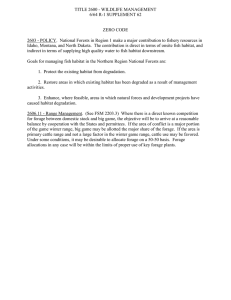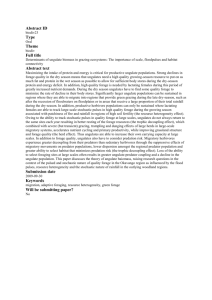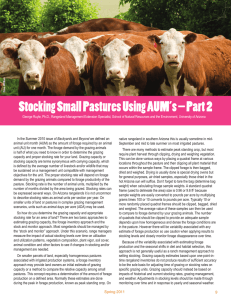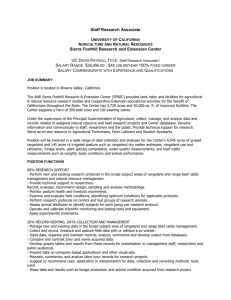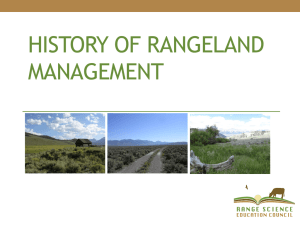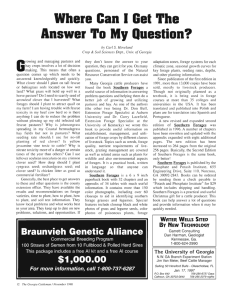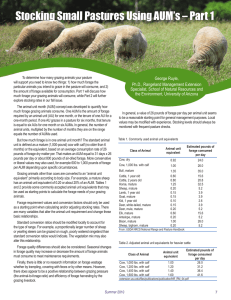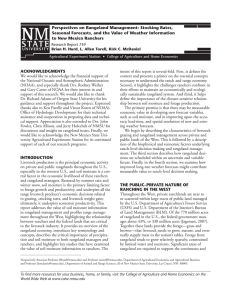WHAT IS AN A.U.M.?
advertisement
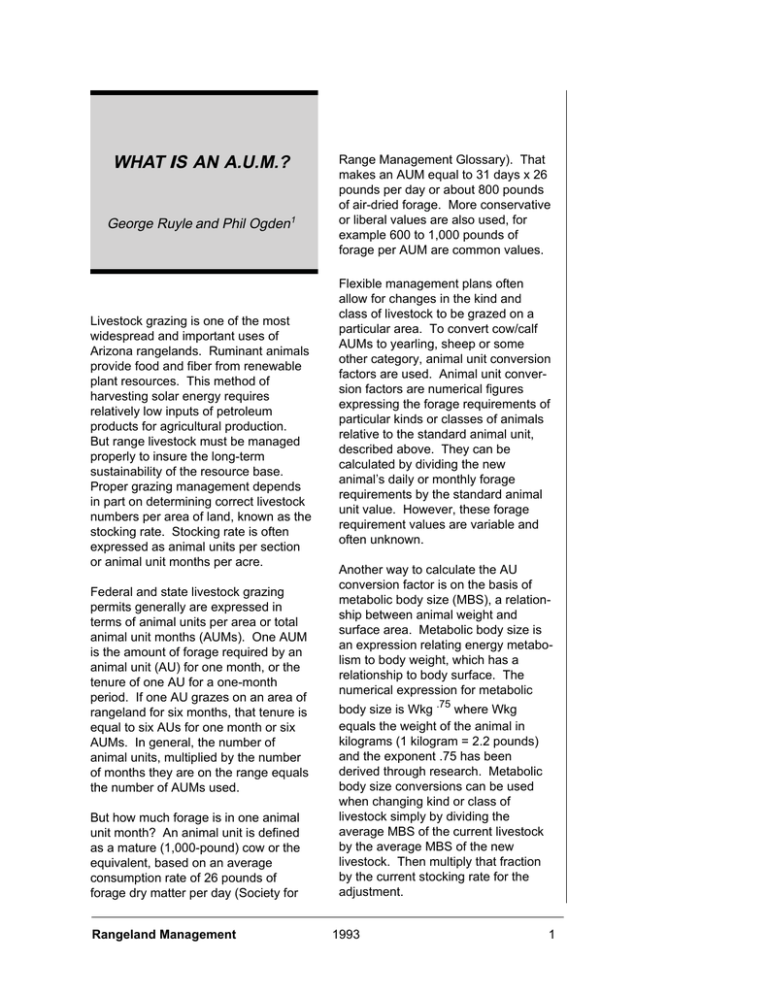
WHAT IS AN A.U.M.? George Ruyle and Phil Ogden1 Livestock grazing is one of the most widespread and important uses of Arizona rangelands. Ruminant animals provide food and fiber from renewable plant resources. This method of harvesting solar energy requires relatively low inputs of petroleum products for agricultural production. But range livestock must be managed properly to insure the long-term sustainability of the resource base. Proper grazing management depends in part on determining correct livestock numbers per area of land, known as the stocking rate. Stocking rate is often expressed as animal units per section or animal unit months per acre. Federal and state livestock grazing permits generally are expressed in terms of animal units per area or total animal unit months (AUMs). One AUM is the amount of forage required by an animal unit (AU) for one month, or the tenure of one AU for a one-month period. If one AU grazes on an area of rangeland for six months, that tenure is equal to six AUs for one month or six AUMs. In general, the number of animal units, multiplied by the number of months they are on the range equals the number of AUMs used. But how much forage is in one animal unit month? An animal unit is defined as a mature (1,000-pound) cow or the equivalent, based on an average consumption rate of 26 pounds of forage dry matter per day (Society for Rangeland Management Range Management Glossary). That makes an AUM equal to 31 days x 26 pounds per day or about 800 pounds of air-dried forage. More conservative or liberal values are also used, for example 600 to 1,000 pounds of forage per AUM are common values. Flexible management plans often allow for changes in the kind and class of livestock to be grazed on a particular area. To convert cow/calf AUMs to yearling, sheep or some other category, animal unit conversion factors are used. Animal unit conversion factors are numerical figures expressing the forage requirements of particular kinds or classes of animals relative to the standard animal unit, described above. They can be calculated by dividing the new animal’s daily or monthly forage requirements by the standard animal unit value. However, these forage requirement values are variable and often unknown. Another way to calculate the AU conversion factor is on the basis of metabolic body size (MBS), a relationship between animal weight and surface area. Metabolic body size is an expression relating energy metabolism to body weight, which has a relationship to body surface. The numerical expression for metabolic body size is Wkg .75 where Wkg equals the weight of the animal in kilograms (1 kilogram = 2.2 pounds) and the exponent .75 has been derived through research. Metabolic body size conversions can be used when changing kind or class of livestock simply by dividing the average MBS of the current livestock by the average MBS of the new livestock. Then multiply that fraction by the current stocking rate for the adjustment. 1993 1 For example, if you are now grazing five hundred 1,000-pound cows on an area and want to convert to 600-pound steers, completing the following steps will calculate the conversion factor and the number of steers you should run. would be 500 x 1.67 or 835 steers for 500 cows. On large-scale rangeland operations, weight conversions are usually adequate. Common conversion factors, based on metabolic body sizes are listed in Table 1. 1. convert pounds to kilograms CAUTION! Forage requirement values and conversion factors should only be used as a starting point when calculating and/or adjusting stocking rates. There are many variables that alter the animal unit requirement and change these basic relationships. 1,000 lbs x 0.45 kg/lbs = 450 kg 600 lbs x 0.45 kg/lbs = 270 kg 2. take these values to the .75 power 450.75 = 98 Standard conversion ratios should be modified locally to account for the type of range. For example, a proportionally larger number of sheep or yearling steers can be grazed on rough, poorly watered rangeland than standard conversion ratios would indicate. The vegetation mix may also alter this relationship. 270.75 = 67 3. divide the current (cow) weights by the new (steer) weights 98/67 = 1.5 = the conversion factor 4. multiply the cow herd size by the conversion factor 500 cows x 1.5 = 750 steers Forage quality differences should also be considered. Seasonal changes in forage quality may increase or decrease the amount of forage animals must consume to meet maintenance To simplify matters, many people prefer the straight conversion by weight alone. In the above example, this would be 1,000/600 = 1.67. So the conversion Table 1. Approximate Numbers of Individual Animals (Conversion Factor) per Standard Animal Unit Calculated by Using the Ratio of Metabolic Weights (wt. kg 0.75). Species Average lb. Weight kg. 0.75 kg. Ratio Conversion Factor Cow 1,000 450 98 1.00 1.0 Horse 1,100 495 105 0.93 0.9 Elk 600 270 67 1.46 1.5 Mule Deer 125 56 21 4.67 4.5 Sheep 120 54 20 4.90 5.0 90 41 16 6.13 6.0 Pronghorn Antelope Rangeland Management 1993 2 requirements. Animal needs also change over the year. Animal demands are much greater during lactation, a rule of thumb is a 33% increase in protein and a 50% increase in energy requirements. Forage requirements are not uniform over various sized animals. Small animals consume more per unit of weight than larger animals. Metabolic weight conversions can be used where necessary to reduce this error. Finally, there is little or no research information on forage wastage whether by trampling, covering with feces or by other means. However, there does appear to be a positive relationship between grazing pressure (the animalto-forage ratio) and efficiency of forage harvesting by the grazing livestock. In general, a value of 26 pounds of forage per day per animal unit seems to be a reasonable starting point for management purposes. Local values may be modified by the U.S. Forest Service, Bureau of Land Management or Soil Conservation Service procedures. But these values should be used only as a guide. Stocking rates should be continually monitored through range trend analysis. Range Management Specialists1 School of Renewable Natural Resources College of Agriculture The University of Arizona Tucson, Arizona 85721 Rangeland Management 1993 3 FROM: Arizona Ranchers' Management Guide Russell Gum, George Ruyle, and Richard Rice, Editors. Arizona Cooperative Extension Disclaimer Neither the issuing individual, originating unit, Arizona Cooperative Extension, nor the Arizona Board of Regents warrant or guarantee the use or results of this publication issued by Arizona Cooperative Extension and its cooperating Departments and Offices. Any products, services, or organizations that are mentioned, shown, or indirectly implied in this publication do not imply endorsement by The University of Arizona. Issued in furtherance of Cooperative Extension work, acts of May 8 and June 30, 1914, in cooperation with the U.S. Department of Agriculture, James Christenson, Director, Cooperative Extension, College of Agriculture, The University of Arizona. The University of Arizona College of Agriculture is an Equal Opportunity employer authorized to provide research, educational information and other services only to individuals and institutions that function without regard to sex, race, religion, color, national origin, age, Vietnam Era Veteran’s status, or handicapping conditions. Rangeland Management 1993 4

